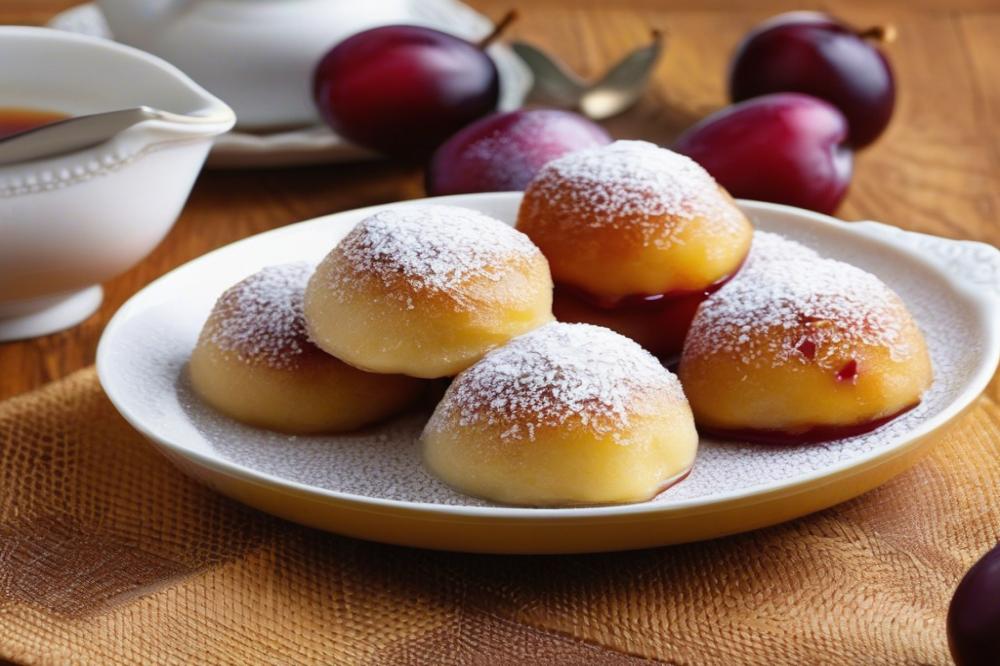Introduction
Azeitão cheesecake is a delightful dessert that captures the essence of Portugal’s rich culinary traditions. Made with a creamy blend of ingredients, this cheesecake stands out thanks to its base of Queijo de Azeitão, a cheese that hails from the Azeitão region. Known for its smooth texture and creamy consistency, this cheese is a key element in many traditional recipes, particularly those that highlight Portuguese desserts.
The importance of Queijo de Azeitão in this cheesecake recipe cannot be overstated. It adds a depth of flavor that elevates the dessert to new heights. The cheese’s slight tanginess perfectly balances the sweetness, creating a harmonious dessert experience. Many chefs and home cooks alike turn to it when seeking an authentic taste of Portugal.
This version of the cheesecake brings an exciting twist to the classic recipe by incorporating citrus fruits. The addition of Portuguese citrus infuses the dessert with vibrant flavors that contrast beautifully with the rich cheese. Each bite delivers a refreshing burst of zest, enhancing the overall character of the dish. Citrus flavors such as orange or lemon add brightness, making the dessert feel light, even with its creamy base. This dessert twist transforms a beloved classic into something truly special.
What is Azeitão cheesecake?

History and Origins of Azeitão Cheesecake
Azeitão cheesecake finds its roots in the charming region of Azeitão, located south of Lisbon, Portugal. This area is renowned for its rich agricultural landscape and continues to inspire local culinary traditions. Traditionally, cheesecakes were simple desserts made from easily accessible ingredients. Over time, the flavors and recipes evolved, giving rise to the Azeitão version. Local cheese, especially from sheep’s milk, became a key ingredient. As generations passed, this dessert transformed into a staple of Portuguese celebrations and gatherings.
Description of Queijo de Azeitão
Queijo de Azeitão is a soft, creamy cheese, deeply cherished in Portugal. It boasts a distinct flavor profile, with notes that hint at the rich pastures where the sheep graze. This cheese has a slightly tangy taste, which pairs beautifully with sweet elements in a dessert. The texture is smooth, almost spreadable, making it an excellent choice for the cheesecake recipe. Its origins can be traced back to local farming traditions, where manual techniques are still used to create this delightful cheese. The use of Azeitão cheese elevates the dessert, creating a luxurious experience with every bite.
Overview of Traditional Cheesecake Recipes in Portugal
Cheesecake holds a special place in Portuguese desserts. Various regions offer their own takes on this beloved treat. For example, in the northern areas, creamy cottage cheese blends with eggs and sugar to form a more traditional style cheesecake. Many recipes incorporate local citrus fruits, which enhance flavor and add brightness to the dish. Bakes range from fluffy to denser textures, with each cook adding their personal touch. Unlike American-style cheesecakes, Portuguese versions often feature lighter flavors. They focus more on creamy cheese than on excessive sweetness. With every recipe, the incorporation of these delightful elements reflects the cultural diversity of Portugal, giving each cheesecake its special story.
Ingredients and Method for Azeitão Cheesecake with Citrus Twist

Ingredients list
- 250g Queijo de Azeitão
- 200g cream cheese
- 150g sugar
- 3 large eggs
- 200ml sour cream
- Zest of 1 orange
- Zest of 1 lemon
- 1 vanilla bean
- 150g digestive biscuits (for base)
- 75g unsalted butter (melted)
Nutritional information
This creamy cheesecake has a caloric content primarily from the Queijo de Azeitão, cream cheese, and sugar. Each ingredient contributes to the overall flavor and texture. The macronutrients for each ingredient vary, with cheese providing protein and fats, while sugar adds carbohydrates. Consider checking specific product labels for precise details.
Method
Start your baking adventure by preheating the oven to 180°C (350°F). This step is crucial for achieving the right texture. While waiting, prepare the biscuit base. Crush the digestive biscuits and mix them with melted butter. Press this mixture into the bottom of a springform pan. The base should be firm and even.
Next, combine the Queijo de Azeitão and cream cheese in a large bowl. Use a mixer for a smooth and airy consistency. Add the sugar gradually. Beat in the eggs one at a time to create a creamy cheesecake batter. Stir in the sour cream, orange zest, lemon zest, and seeds scraped from the vanilla bean. This mixture will bring the wonderful citrus flavors together.
Pour this creamy filling over the biscuit base. Bake in the preheated oven for about 45 minutes. The edges should be set, while the center remains slightly jiggly. Allow it to cool at room temperature. Once cool, refrigerate the cheesecake for at least four hours. This chilling time is essential for the flavors to meld and deepen.
Exploring Citrus Flavors in Portuguese Cuisine

Popular citrus fruits in Portugal
Citrus fruits play an important role in Portugal’s culinary landscape. Oranges, lemons, and limes are among the most cherished. These fruits grow abundantly in the sunny regions, contributing to vibrant flavors. Portugal, especially the Algarve, is famous for its sweet oranges. Their bright, juicy segments offer both zest and sweetness. Lemons add a tangy bite, perfect for balancing rich dishes. Limes bring a refreshing touch to beverages and desserts alike. Each fruit brings its brightness to the table, enhancing the Portuguese palate.
How citrus enhances desserts
In desserts, citrus flavors work wonders. They elevate the sweetness of creamy cheesecake, providing a contrast that keeps the taste exciting. Citrus can cut through richness and makes dishes feel lighter. The freshness from these fruits is inviting and refreshing. Some recipes incorporate citrus zest, adding depth to flavors. Others use juice, which adds a bright note. Given their versatility, citrus fruits can transform traditional recipes. The zing of citrus can truly make a dessert shine.
Adding a Portuguese twist to classic recipes with citrus
Incorporating a Portuguese twist to classic cheesecakes can lead to delightful outcomes. Consider a cheesecake recipe that features Queijo de Azeitão, a creamy cheese from the Setúbal region. Pairing this cheese with a lemon or orange glaze can tie everything together beautifully. Adapting traditional recipes with local flavors creates something exciting. Each bite of the Azeitão cheesecake with a citrus sauce can tell a story of its origins. Baking with cheese opens up new possibilities. By utilizing citrus, one can craft a dessert twist that feels innovative yet familiar. Portuguese desserts hold a treasure trove of flavors, each waiting to be explored further.
Serving Suggestions and Pairing

Best Presentation Styles for Azeitão Cheesecake
Plating a creamy cheesecake can be an art form. Use a simple white plate to contrast the rich colors of the dessert. A drizzle of citrus sauce around the edges can enhance the visual appeal. Slices can be cut into triangles or squares for variety. Garnishing with fresh mint leaves adds a splash of green. Consider serving individual portions in glass jars for a modern twist that showcases layers beautifully.
Recommended Side Dishes or Garnishes
Complementing the cheesecake with fruits is a delightful idea. Fresh citrus fruits, like oranges or grapefruits, can provide a refreshing bite. A light berry compote can also bring sweetness and tartness to the table. For a crunch factor, toasted nuts like almonds or pistachios work nicely. These textures contrast well with the smoothness of the dessert, making every mouthful interesting. A dusting of powdered sugar over the top adds an elegant touch, too.
Drink Pairings That Complement the Dessert
Choosing the right beverage can elevate the tasting experience. A glass of Port wine brings out the rich flavors of Azeitão cheese beautifully. For a non-alcoholic option, a sparkling citrus lemonade offers a zesty twist without being overpowering. Green tea can provide a light counterpart, enhancing the cheesecake’s creamy texture. Some might prefer a fruity herbal tea; its aroma complements traditional recipes perfectly. Whichever you select, the key is to balance flavors and keep the focus on those citrus notes.
The Appeal of Creamy Cheesecake in Portuguese Desserts
The texture of a creamy cheesecake is delightful. Each bite melts smoothly in your mouth, creating a comforting sensation. Flavors blend seamlessly in this dessert, enhancing its rich essence. In many ways, this cake embodies the heart of Portuguese desserts. Popular among locals and visitors alike, it offers a delightful balance of taste.
Creaminess holds a special place in Portuguese sweets. Many traditional recipes showcase this quality. Whether in pastries or puddings, the rich smoothness is a sign of expert baking with cheese. The love for creamy textures often influences how desserts are prepared. A cheesecake recipe that incorporates local ingredients truly stands out.
When comparing Azeitão cheesecake to local favorites, the difference is clear. Tarts filled with custard tempt many, but the cheesecake shines bright with its unique layers of flavor. Other traditional desserts, like pastéis de nata, might emphasize crispiness, while this cake adds fullness to the palate. Citrus fruits elevate the Azeitão cheesecake, bringing a refreshing twist. Their bright flavors contrast well against the mildness of Azeitão cheese.
Eventually, the combination of local cheese and citrus creates a dessert rarely found elsewhere. The result is a flavor that is both familiar and surprising. Each slice invites people to discover something special. The journey into this unique cheesecake reflects the rich tapestry of Portuguese culinary traditions.
Wrap-Up on the Azeitão Cheesecake Experience
The delightful Azeitão cheesecake is more than just a dessert; it embodies the rich flavors and traditions of Portuguese cuisine. Made primarily with Queijo de Azeitão, this creamy treat captures the essence of the region’s dairy heritage. Its smooth texture and balanced sweetness make it a favorite among both locals and visitors. Understanding its roots deepens our appreciation for this culinary gem.
Adding a citrus twist elevates the classic flavor profile. The zesty notes of lemon or orange create a refreshing contrast to the rich, creamy base. This blend showcases how versatile dessert recipes can be without losing their essence. The citrus highlights the natural flavors of the cheesecake, allowing each bite to be a celebration of taste.
Now is the time to dive into this cheesecake recipe. Don’t hesitate to embrace the opportunity to explore Portuguese flavors in your kitchen. Making this dessert is not just about following steps but about enjoying the process. Gather your ingredients and share this delightful treat with family and friends. Experience the joy that comes with every forkful of Azeitão cheesecake, and let the flavors transport you to the vibrant landscapes of Portugal.



